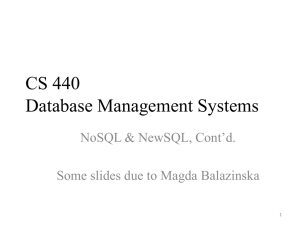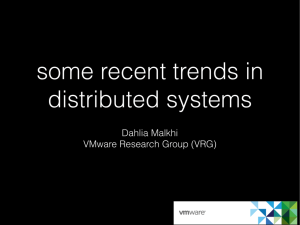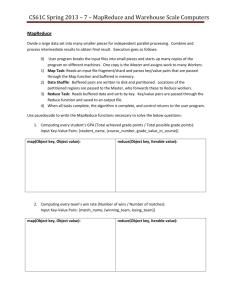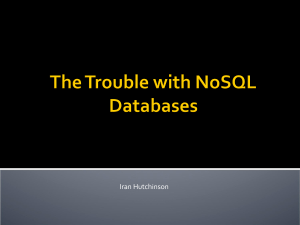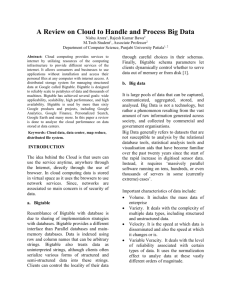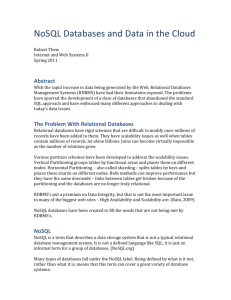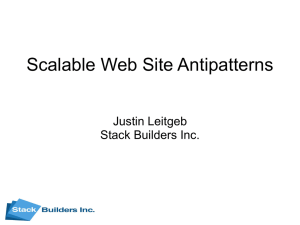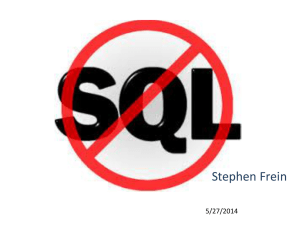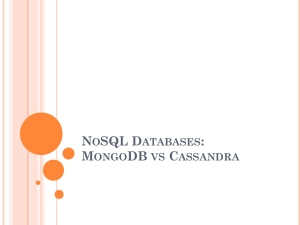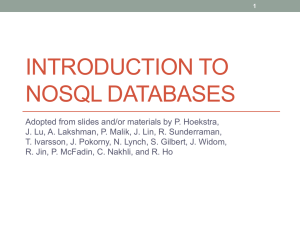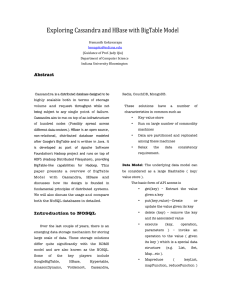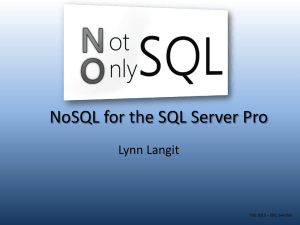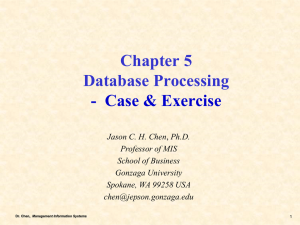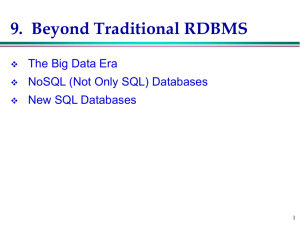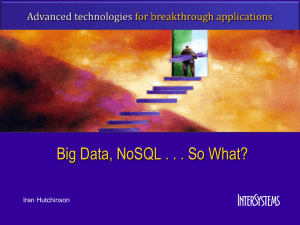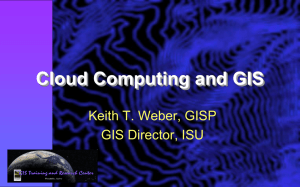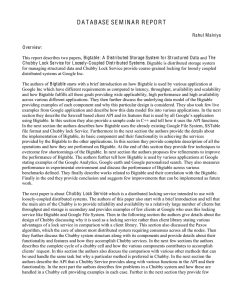Data Management in the Cloud
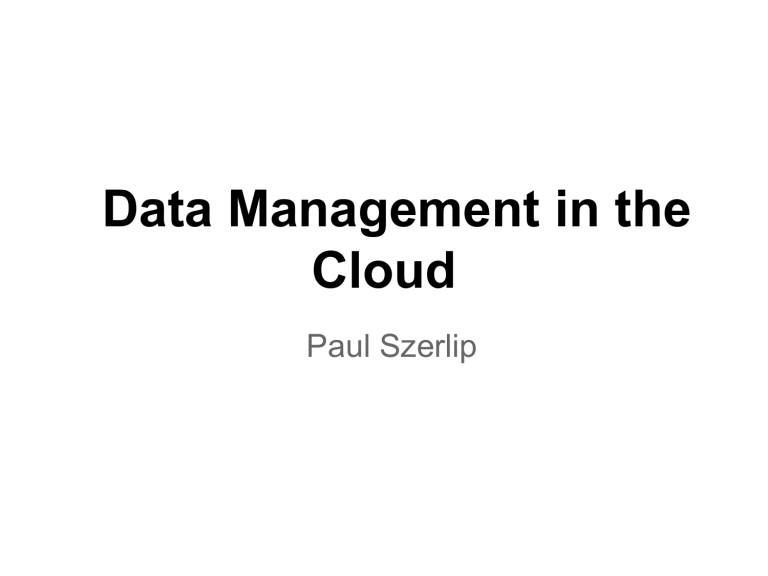
Data Management in the
Cloud
Paul Szerlip
The rise of data
•
Think about this o o
For the past two decades, the largest generator of data was humans -- now it's our devices
•
Cheap sensors
Cellphones are packed with sensory information
Images, video, audio, etc
•
Expensive sensors o DZero, high energy physics, generates 1 TB a day
•
How do you deal with that much data?
[1,2]
Data in the cloud
•
Storing the data o Bigtable, S3, NoSQL, etc
•
Processing the data o MapReduce, Hadoop, etc
Good data management in the cloud
•
Availability o Accessible in cases of partial network failure or datacenter failure
•
Scalability o Support for massive database sizes - spread across many servers
•
Elasticity o Scaling up and scaling down
•
Performance o Efficient system storage utilization
•
Multitenancy o Many applications on the same hardware
Good data management
(continued)
•
Load and Tenant Balancing o Moving load between servers
•
Fault Tolerance o Tolerating network or hardware failures
•
Running in heterogeneous environment o Dealing with hardware degredation
•
Flexible query interface o Providing ways to access both SQL and non-SQL languages
Overarching Themes
•
Frustration with ACID on the cloud o (Atomicity, consistency, isolation, durability)
•
Hard to maintain ACID guarantees with data replication over large geographic distances [1] o Consistency, Availability, Tolerance to partitions, choose 2
•
Rise of NoSQL (a misnomer) [2] o Eventually consistent can be okay, some ACID properties are relaxed or left to application developers
Investigating 3 Systems
•
Bigtable (Google) o And quick look at MapReduce
•
Amazon:S3/SimpleDB
•
Open source NoSQL alternatives: o Cassandra (key-value) o MongoDB (document)
Bigtable
•
Distributed storage designed to scale to petabyte size databases spread across thousands of servers [1]
•
Used extensively by Google
•
Not fully relational o "Sparse, distributed, persistent multidimentional sorted map" [1]
•
Uses Google File System (GFS) under the hood
•
Index using row keys o Tablet = range of row keys, used for load balancing
Bigtable Diagram [2]
Bigtable
•
GFS o SSTable
Provides a persistent immutable ordered map o
Chubby provides locking mechanism
Ensures single master
Location of bigtable data
Storing schema information and access control lists
•
Each Bigtable is allocated to one master, and many multiple tablet servers o Master assigns tablets to different tablet servers, dynamically based on server load
Tablets handle read-write
MapReduce
•
Introduced by Google in 2004 [1]
•
Often used to operate on Bigtable data [1]
•
A means to process large amounts of data in a distributed environment in a highly parallelized manner
MapReduce Steps
1. Input files split into M pieces, multiple copies of program started on cluster
2. One copy is master, M map tasks, R reduce tasks assigned to idle workers
3. Worker reads file split contents, passes to map function - results buffered in memory
4. Buffered results written to local disk periodically, partitioned into R regions by partitioning function, locations passed to master
MapReduce (continued)
5. Reduce worker notified about location, reads buffered data from map workers, sorts so that same keys are grouped together
6. Reduce worker passes key and intermediate values to Reduce function, output is appended to final output file
7. After all map and reduce tasks completed, master wakes up user program
S3 - Simple Storage Service
•
"Infinite" store for objects of variable size [1]
•
Organized in 2 levels o Buckets
Like folders, you can save any number of objects in them o Objects
Byte container (up to 5 GB) and metadata (up to
2KB)
•
Limited search o Single bucket, name only
SimpleDB
•
Organized into domains (tables) where you can insert data, get data, or run queries [1]
•
Each domain has items which are descibed by attribute name/value pairs
•
No schema
•
API Accesso CreateDomain, DeleteDomain, PutAttributes,
DeleteAttributes, GetAttributes, and Select
•
Meant for fast reads
•
Keeps multiple copies of the domains
NoSQL
•
What does this mean?
o More about relaxing ACID than being "No" SQL [2]
•
Lots of open source NoSQL systems o Zynga was big on NoSQL
•
Why to use them?
o Excellent elasticity o o o
Flexible data models - often schema-less
CHEAP (relative to RDBMS)
(if you have lots of frequent and small writes)
Types of NoSQL
•
Key-value o Redis, Cassandra, etc.
•
Document store o CouchDB, mongoDB, etc
•
Graph dbs, object stores o Won't go into these much
Cassandra
•
Highly scalable, eventually consistent, distributed, structured, key-value store [1]
•
Open sourced by Facebook (2008) [1]
•
ColumnFamily based o Column is a tuple of {key, value, timestamp} o ColumnFamilies contain many columns, all referenced by row-key
•
Kind of like a hybrid of Dynamo and Bigtable
[1]
MongoDB
•
Document-oriented o High input read/write o High availability o o
Scalability
Flexible query language
References
•
[1] Sakr, S., Liu, A., Batista, D.M., Alomari,
M., A Survey of Large Scale Data
Management Approaches in Cloud
Environments, IEEE Communications, 2011.
•
[2] Cloud Computing: Theory and Practice
(our lecture notes)
•
[3] http://www.mongodb.org/display/DOCS/Intro duction
